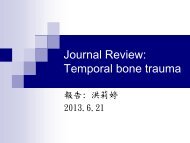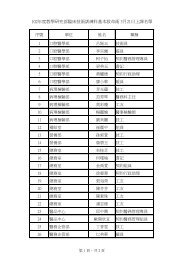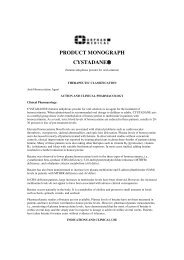Pneumothorax and Chest Tube Problems
Pneumothorax and Chest Tube Problems
Pneumothorax and Chest Tube Problems
You also want an ePaper? Increase the reach of your titles
YUMPU automatically turns print PDFs into web optimized ePapers that Google loves.
<strong>Pneumothorax</strong> <strong>and</strong><br />
<strong>Chest</strong> <strong>Tube</strong> <strong>Problems</strong>
<strong>Pneumothorax</strong><br />
• Definition<br />
Air accumulation in the pleural space with secondary lung<br />
collapse<br />
• Sources<br />
– Visceral pleura<br />
– Ruptured esophagus<br />
– <strong>Chest</strong> wall defect<br />
– Gas-forming organisms<br />
• Factors determining gas reabsorption<br />
– Diffusion properties of the gases<br />
– Pressure gradients<br />
– Area of contact<br />
– Permeability of pleural surface
Classification of <strong>Pneumothorax</strong><br />
• Spontaneous<br />
– Primary<br />
– Secondary<br />
•COPD<br />
• Infection<br />
• Neoplasm<br />
• Catamenial<br />
• Miscellaneous<br />
• Traumatic<br />
– Blunt<br />
– Penetrating<br />
•Iatrogenic<br />
– Inadvertent<br />
– Diagnostic<br />
– Therapeutic
Primary Spontaneous<br />
<strong>Pneumothorax</strong><br />
• Symptoms <strong>and</strong> signs<br />
– Sudden onset chest pain<br />
– Shortness of breathing<br />
– Non-productive cough<br />
• Physical examination<br />
– Decrease in chest wall movement on inspection<br />
– <strong>Chest</strong> cavity hyperesonant <strong>and</strong> tympanic on percussion<br />
– Decrease breath sounds on auscultation<br />
• Diagnosis—CXR<br />
• Differential diagnosis<br />
– Skin fold<br />
– Giant bulla
<strong>Pneumothorax</strong> (Left)
<strong>Pneumothorax</strong> (Right Apex)
<strong>Pneumothorax</strong> (Right)
Pneumohemothorax
Emphysema of the Lung<br />
- Solitary giant bulla, RLL
Treatment Options for Primary<br />
Spontaneous <strong>Pneumothorax</strong><br />
• Observation<br />
• Needle aspiration <strong>and</strong> small chest tube<br />
drainage<br />
• Convention tube thoracostomy<br />
– Water seal Pleur-evac type<br />
– Heimlich valve<br />
• <strong>Tube</strong> thoracostomy with instillation of<br />
pleural irritant—Tetracycline HCL, Talc<br />
• Surgical intervention
Indications for Surgical<br />
Intervention<br />
• Second episode<br />
• Persistent air leakage for greater than 7-10 days<br />
• First episode with unexp<strong>and</strong>ed, “trapped” lung<br />
• History of contralateral pneumothorax<br />
• Bilateral pneumothorax<br />
• Occupational risk (driver, airplane pilot)<br />
• Living in a remote area<br />
• Large bulla<br />
• Large undrained hemothorax<br />
• First episode in a patient with one lung<br />
• First episode in a patient with severely<br />
compromised pulmonary function
Surgical Intervention for Primary<br />
Spontaneous <strong>Pneumothorax</strong><br />
• Principal<br />
– Resection of the blebs or bulla<br />
– Obliteration of the pleural space<br />
• Approach<br />
– Video-assisted thoracoscopic surgery<br />
– Thoracotomy<br />
• Procedures for obliteration of the pleural space<br />
– Parietal pleurectomy<br />
– Abration pleurodesis<br />
– Laser pleurodesis
Vertical Approach for<br />
<strong>Pneumothorax</strong><br />
Apical Blebs
Recurrence of Primary<br />
Spontaneous <strong>Pneumothorax</strong><br />
• Therapy Recurrence (%)<br />
– Expectant 30<br />
– Aspiration 20-50<br />
– <strong>Chest</strong> tube drainage 20-30<br />
– Pleurodesis (tetracycline) 25<br />
– Pleurodesis (talc) 7<br />
– Surgery 2
Complication of Primary<br />
Spontaneous <strong>Pneumothorax</strong><br />
• Tension pneumothorax<br />
• Re-expansion pulmonary edema<br />
• Persistent air leak<br />
• Hemothorax (
Indications for<br />
<strong>Tube</strong> Thoracostomy<br />
• <strong>Pneumothorax</strong>--open, tension, trauma or<br />
iatrogenic<br />
• Hemothorax<br />
• Empyema<br />
• Pleural effusion<br />
• Chylothorax<br />
• Post-operative drainage--thoracic or cardiac
<strong>Chest</strong> <strong>Tube</strong> Insertion<br />
• Guide-wire tube thoracostomy<br />
• Trocar tube thoracostomy<br />
• Operative tube thoracostomy
Guide-Wire <strong>Tube</strong> Thoracostomy
Trocar <strong>Tube</strong> Thoracostomy
Operative <strong>Tube</strong> Thoracostomy
Pleural Drainage System<br />
• One-way (Heimlich) valve<br />
• One-bottle collection system<br />
• Two-bottles collection system<br />
• Three-bottles collection system<br />
• Commercial drainage system
One-Way (Heimlich) Valve
One-Bottle Collection System
Two-Bottle Collection System
Three-Bottle Collection System
Commercial Drainage System
Care of <strong>Chest</strong> <strong>Tube</strong>s<br />
• Is there bubbling through the water-seal<br />
bottle/chamber ?<br />
• Is the tube functioning?<br />
• What is the amount <strong>and</strong> type of drainage<br />
from the tube?
Actual Drainage Pressure<br />
The actual negative pressure<br />
in the chest = A-B-C+D
Complications of <strong>Chest</strong> <strong>Tube</strong>s<br />
• Misplacement of chest tube<br />
• Pleural infection
Malposition of <strong>Chest</strong> <strong>Tube</strong>
Malposition of <strong>Chest</strong> <strong>Tube</strong>
Malposition of <strong>Chest</strong> <strong>Tube</strong>
Other Functions for <strong>Chest</strong> <strong>Tube</strong>s<br />
• Injection of Materials<br />
• Auto-transfusion
Thal-Quick <strong>Chest</strong> <strong>Tube</strong> Adapter
Removal of <strong>Chest</strong> <strong>Tube</strong>s<br />
• Indications<br />
• Methods

















